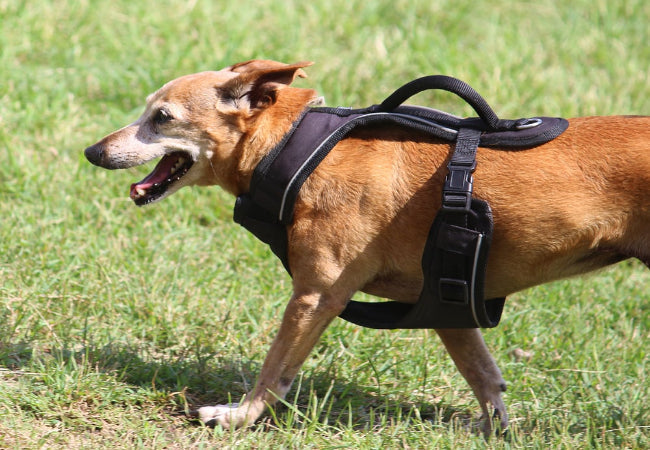Does Your Dog Hate Their Harness? Vet-Approved Tips 2025 🐕💡

In this article
Does Your Dog Hate Their Harness? Vet-Approved Tips 2025 🐕💡
By Dr. Duncan Houston BVSc
Does your dog run and hide when you grab their harness? Do they freeze, resist, or panic during walks? You’re not alone. Many owners assume their dog simply “hates walks”—but the truth is, the problem is often the harness itself.
I’m Dr. Duncan Houston, veterinarian and founder of Woopf. I’ve worked with dogs who’ve developed harness aversion due to pain, poor fit, or bad experiences. The good news? It’s fixable—with the right approach and gear.
Let’s unpack why dogs hate harnesses—and how the Explorer Harness was designed to change that.
🧠 Common Reasons Dogs Hate Their Harness
- ❌ It’s uncomfortable—rubs or pinches under the arms or chest
- ❌ It’s hard to put on—too many buckles, or goes over the head
- ❌ It’s associated with fear (bad walk, traumatic memory, or punishment)
- ❌ It shifts or tightens during walks, causing instability or panic
💥 What This Can Look Like
- 🐶 Refusing to move when harnessed
- 😣 Flattening to the ground or shaking
- 🦴 Nipping at the harness or leash
- 🏃 Running away when it’s time to gear up
These behaviors are often misinterpreted as stubbornness—but they’re signs of discomfort or anxiety.
✅ How the Explorer Harness Solves This
Explorer Harness
- ✔️ Y-front design = no pressure on shoulders or throat
- ✔️ Soft padding throughout = prevents rubbing or chafing
- ✔️ Easy to clip around the chest—no need to pull over the head
- ✔️ Secure, non-slip fit reduces rotation or sudden tightening
- ✔️ Built-in handle provides stability and reassurance in stressful moments
It’s the harness designed to help dogs feel calm, not constrained.
🎓 How to Rebuild Positive Harness Associations
Step 1: Let Your Dog Approach the Harness
- Place the harness on the ground and reward any interest (sniff, nose touch)
- Don’t force it—build curiosity first
Step 2: Practice “Harness = Treat”
- Hold the harness open and offer a treat as your dog steps toward it
- Clip it on loosely and reward again
- Take it off after 30 seconds—before discomfort starts
Step 3: Short, Positive Walks Only
- Keep early walks short and filled with reward, praise, and decompression time
- Don’t push into overwhelming environments too soon
📏 Ensure a Proper Fit
Even the best harness won’t help if it’s too tight or too loose. With the Explorer Harness:
- 📐 Adjust all four points to get a snug, even fit
- 🧪 Use the two-finger test under every strap
- 🔁 Re-check every couple of weeks for growing dogs
📊 Harness Aversion vs Harness Confidence
| Behavior | Cause | Woopf Solution |
|---|---|---|
| Freezing when harnessed | Poor fit or tight chest strap | ✅ Four-point adjustment, padded chest plate |
| Running from the harness | Fear of over-head application | ✅ Side clips—no overhead placement required |
| Pulling harder when scared | Back clip creates drive and panic | ✅ Front clip for redirection and safety |
| Shaking off the harness repeatedly | Shifting harness or friction discomfort | ✅ Secure, anti-slip fit + soft lining |
💬 What Owners Say
“My rescue used to hide when she saw her harness. Now she walks over when I grab the Woopf one—it’s totally changed our routine.” – Jess & Lola
“He used to stop mid-walk and refuse to move. Now, with the Explorer Harness, he trots comfortably by my side.” – Toby P.
🎁 Gear to Rebuild Walk Confidence
- Explorer Harness
- Bungee Lead – Reduces leash tension and panic reactions
- Dual Pocket Dispenser – Use treats to reward calm behaviors
👩⚕️ Need Help with Harness Aversion?
Submit your dog’s behavior notes and a photo. We’ll help identify what’s going wrong and how to get your dog loving walks again.
Final Thoughts
No dog is born hating their harness. If your pup is resisting, it’s their way of saying something isn’t working. With Woopf gear designed by a vet—and tested by real dogs—you can rebuild trust, comfort, and confidence with every walk.



